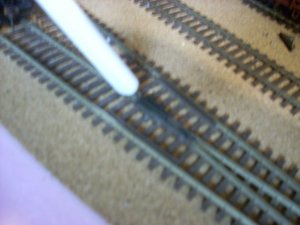I have noticed that some equipment, like locos make a tight fit in some of my atlas switches. When I roll them through with my hand, I can feel the loco get stuck, like the wheels wont fit through. Any ideas? They do go through fine, just wondering what the prob might be.
Atlas switch question
- Thread starter Kevinkrey
- Start date
You are using an out of date browser. It may not display this or other websites correctly.
You should upgrade or use an alternative browser.
You should upgrade or use an alternative browser.
N
nachoman
That's called the "frog". If you don't have one already, pick up an NMRA standards gauge. You can check the gauge of the turnout, and more importantly check the gauge of the wheels of your rolling stock. If it is only some of your rolling stock that has trouble, It is very likely you have wheels that are out of gauge or have flanges that are too deep.
Kevin
Kevin
I only have the problem with a few switches, its no big deal, just wondering. I do think I will pick one up soon.
What kind of turnouts (switches) are they? Custom Line, Snap? and what number (size) if applicable?
Atlas "Snap Switches" are meant to substitute for 18" radius curve, so the restrictions that go with an 18" curve will also apply here.
Some of the smaller/tighter turnouts (low numbers like #4, #5) are also tight for longer equipment.
When you get your gauge and check all the various parts of the turnouts, don't forget to also check the gauge of the wheelsets on your rolling stock. They are the other half of the equation.
Andrew
Atlas "Snap Switches" are meant to substitute for 18" radius curve, so the restrictions that go with an 18" curve will also apply here.
Some of the smaller/tighter turnouts (low numbers like #4, #5) are also tight for longer equipment.
When you get your gauge and check all the various parts of the turnouts, don't forget to also check the gauge of the wheelsets on your rolling stock. They are the other half of the equation.
Andrew
Another thing to watch for with Atlas code 83 switches if that some of them have the frog sitting too high - I first discovered this when my friend cn nutbar brought over some of his brass locos to run. Most of them would stall on certain turnouts, and I finally traced this to the frogs being higher than the rest of the rail. When a couple of the locos' drivers rolled onto the unpowered frog, all of the drivers were lifted from the track on that side of the loco, breaking the current flow to the motor. My plastic steamers, which pick up from all wheels, didn't experience these problems. I probably should've powered the frogs when the track was originally put down, but my simple solution was to make a few passes with a mill fill over the offending frogs, making sure to vacuum up the filings before running trains.
Everybody should have a wheel and track gauge - you'd be surprised at how many cars and locos have out-of-gauge wheelsets right from the box.
Wayne
Everybody should have a wheel and track gauge - you'd be surprised at how many cars and locos have out-of-gauge wheelsets right from the box.
Wayne


